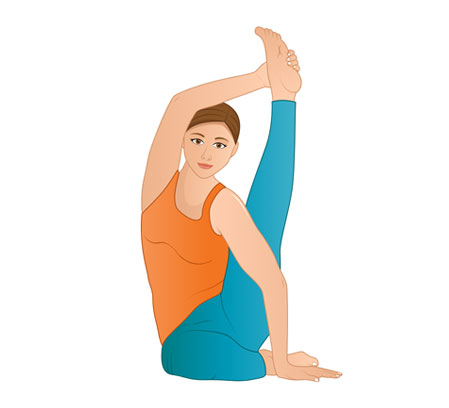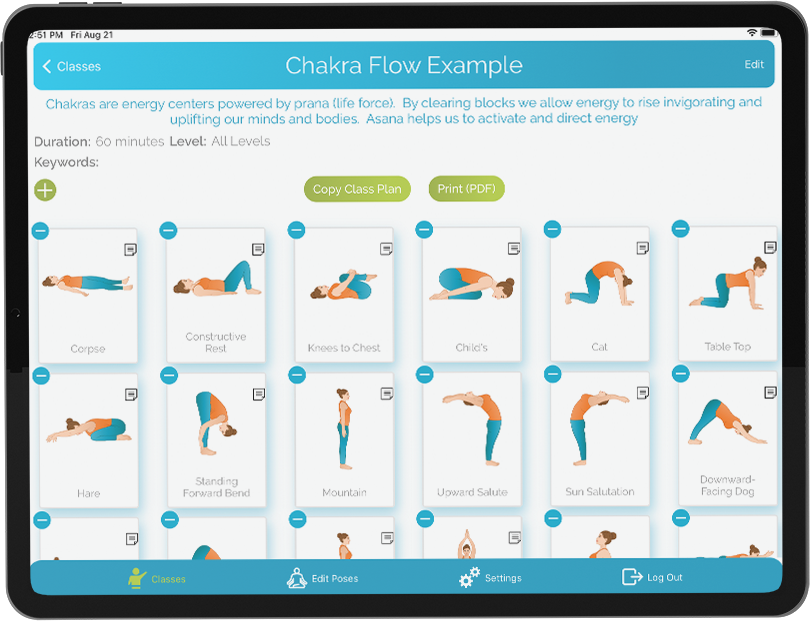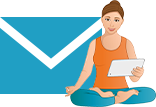COMPASS POSE
PARIVRTTA SURYA YANTRASANA

STEPS
The compass Pose is also known as Revolved Sundial Pose, which is the literal Sanskrit translation of the name of the pose. This is a deep pose which opens the hamstrings, hips, shoulders and chest. Because of the level of flexibility required for this pose, it falls into the intermediate category of yoga poses. The Compass Pose is one that can be performed gracefully to open up the sides while elongating the spine. Most Yoga teachers add this pose as a peak pose in their class plans. The Compass Pose requires equal parts strength and equal parts flexibility to master the pose.
Begin seated in Staff pose with legs stretched out and back long and shoulders open. Bring the left leg closer to the chest by hugging the left knee with both hands. Stay here for a few breaths and rotate the leg to open the hips as a preparation for the pose. Next step is to cradle the left leg, by bringing the left knee into the left elbow and holding the left ankle with the right hand. Breathe here for a few seconds and while cradling the leg and rocking to and fro. Next bring the left leg back to hook over the left shoulder. Fold the right leg in half seated cross-legged pose. Holding the left foot with the right hand, extend the left hand sideward by slightly bending your back. The final step is to hold firm the left foot with right hand and extend to straighten the left leg. Press into the left fingers as you add length to the extended right side of the body. Further straighten the left leg, while gazing upwards towards the right side.
To come out of the pose, release the straightened leg back over the knee. Bring the left hand to hug the left leg. Release the left leg back to Staff Pose.
TEACHER QUEUES
VISUALIZATION COMMENTS
Imagine being grounded by the earth’s gravitational pull as you sink in deeper and stabilising the core in this posture. While stretching the hamstring over and above, lift your gaze to the sky while imagining the right side blossoming open to the sun. Enjoy the balance and relaxation like that of a steady compass, firm and grounded while always aware of the direction it’s seeking out.
TECHNICAL COMMENTS
One needs to be firmly and comfortably seated on the mat. Avoid putting too much pressure on the folded knee. The thigh that is resting on the mat, might lift up while opening into the pose. While stretching the leg and hamstrings into the pose, use the corresponding fingertips to help ‘wriggle’ the shoulder a little deeper. The back can arch slightly while placing the knee over on the shoulder.
BENEFIT COMMENTS
- Opens the hips, obliques, hamstrings and chest.
- Allows the spine to become more flexible.
- Stimulates the internal organs, especially the digestive system.
- Allows the practitioner to become more patient with more patience.
- Relieves stress and constipation
- Strengthens lower back and hips.
WATCH OUT FOR
- Stiff and tight hamstrings
- Tight Hips
- A pressure in the knee joints.
- Bent back
- Stiff obliques
CONTRAINDICATIONS
- Hamstring injury
- Back or spinal cord injuries
- Hip replacements or injuries.
MODIFICATIONS
- Use a strap to hook the ankle to stretch hamstring before opening into the pose.
- A blanket if the seated knee is lifting off the ground.
VARIATIONS
- Archer Pose
- Standing compass pose
- Heron Pose
- Head to Knee forward bend pose
YOGA COUNTER POSES
Written By: Adithi
Adithi Mathews is a 500 Hr CYT,yoga practitioner and writer living in Germany. More information about Adithi can be found on www.adithimathews.com



